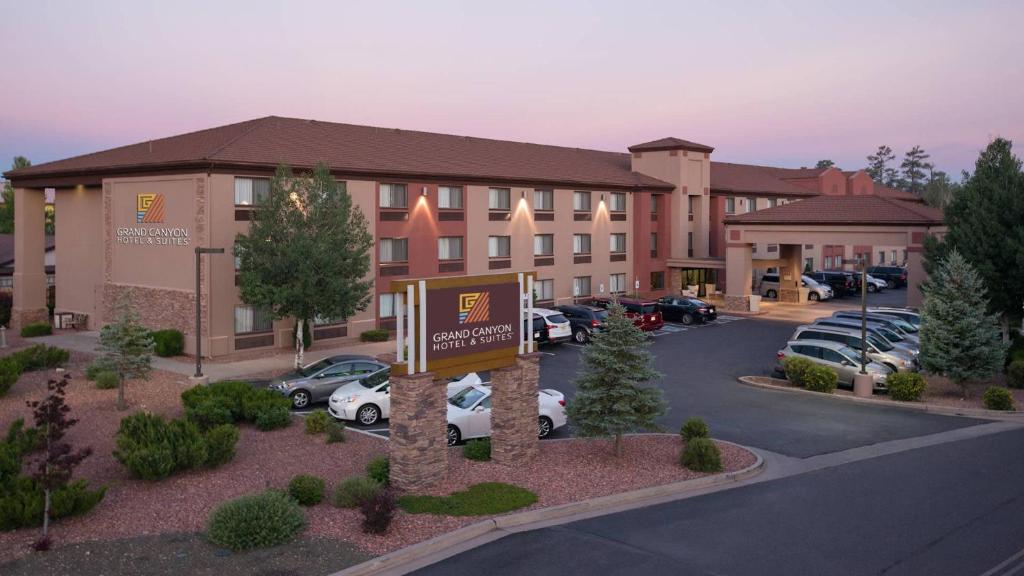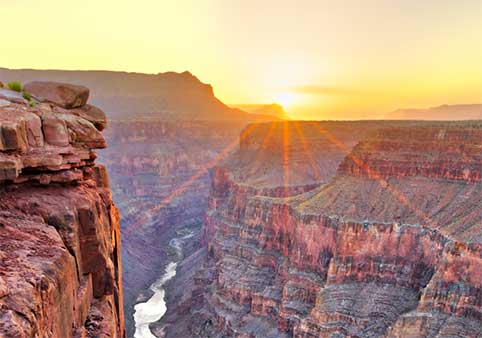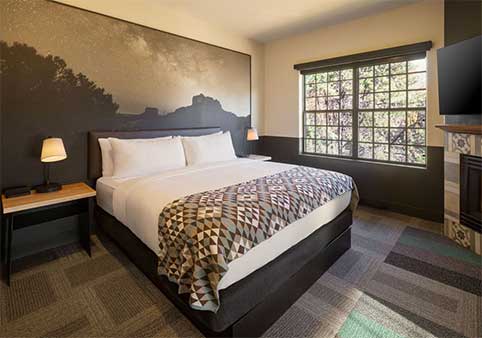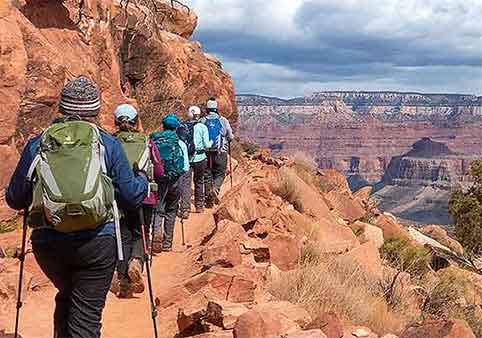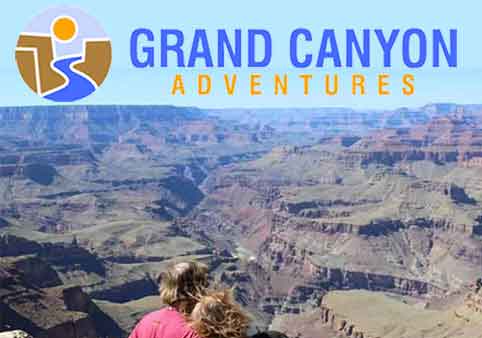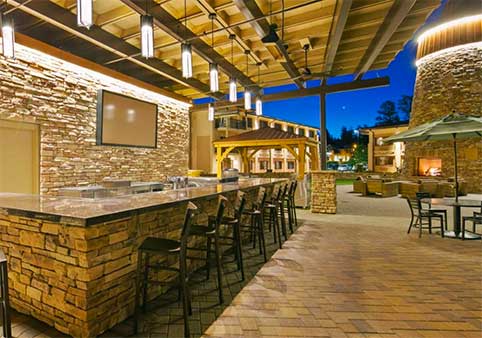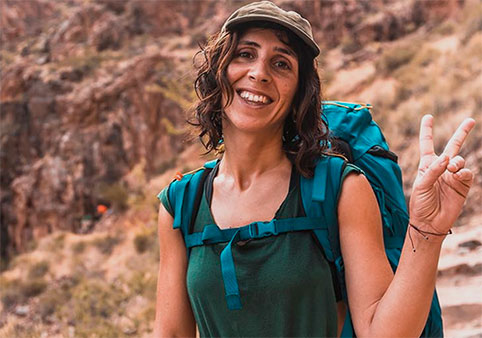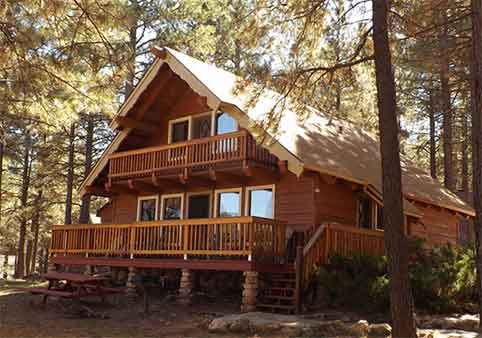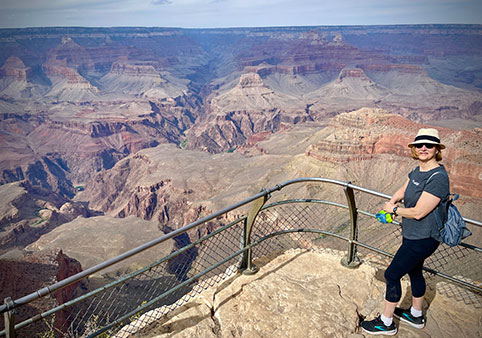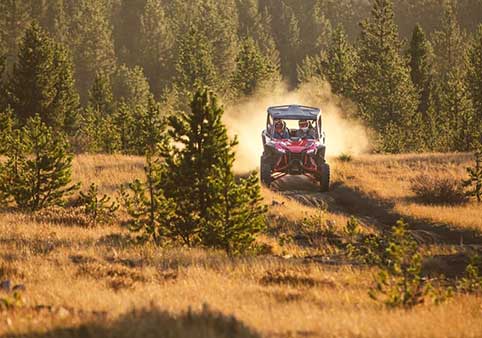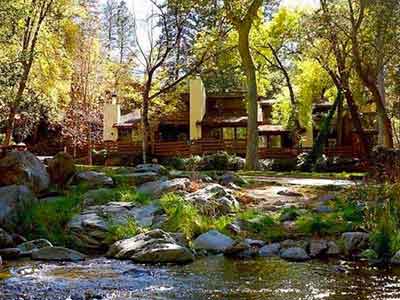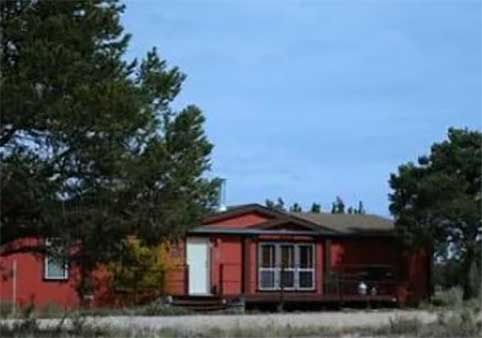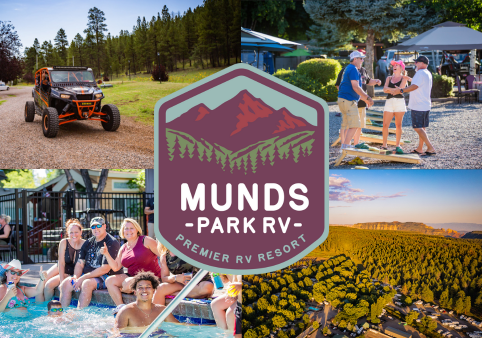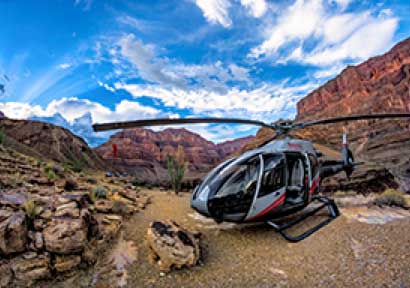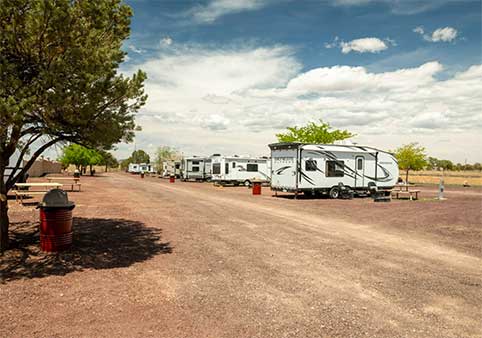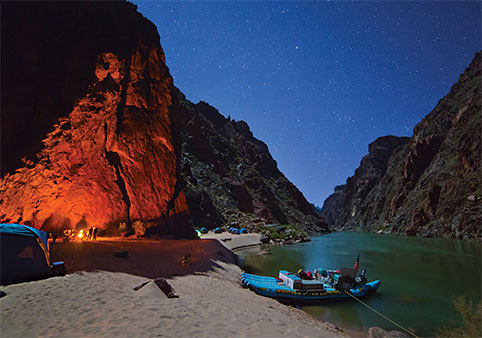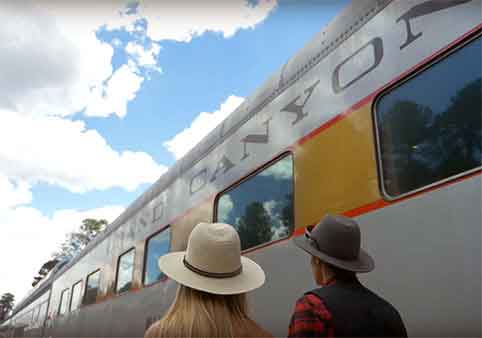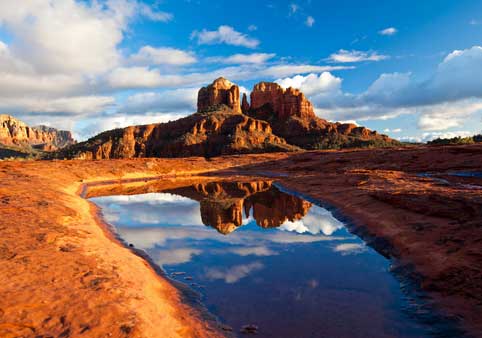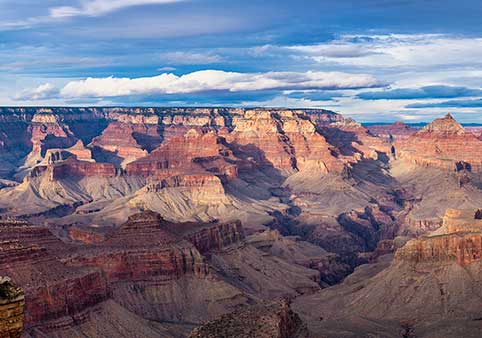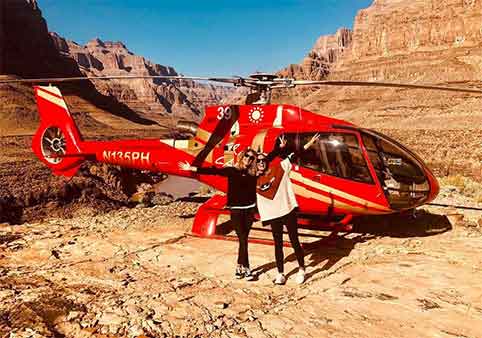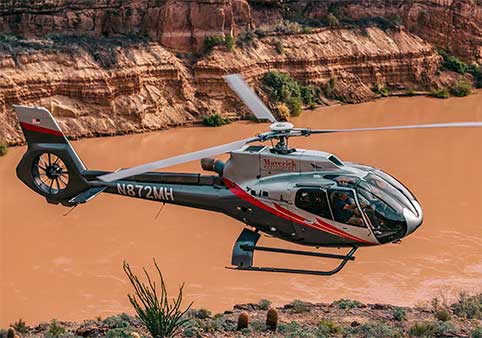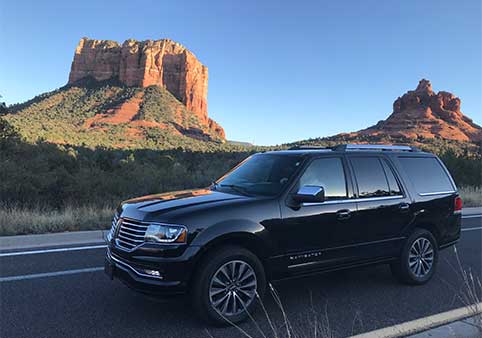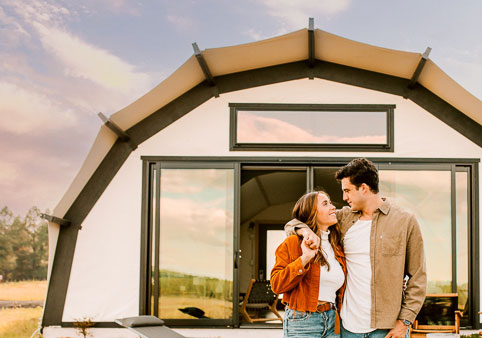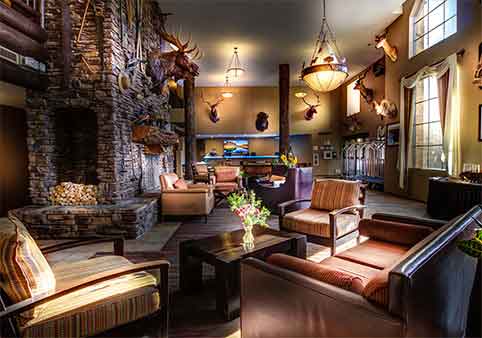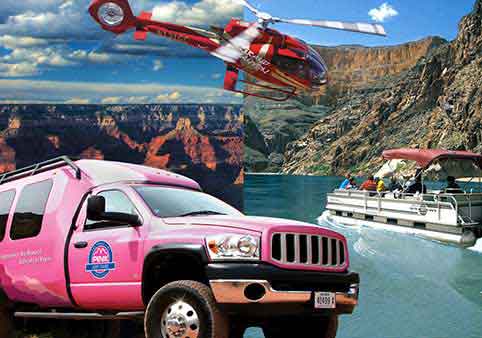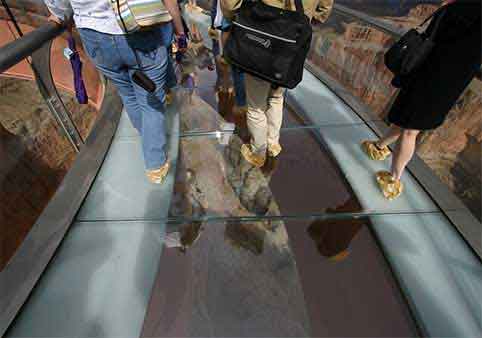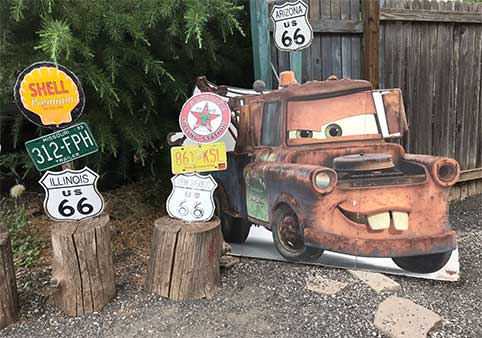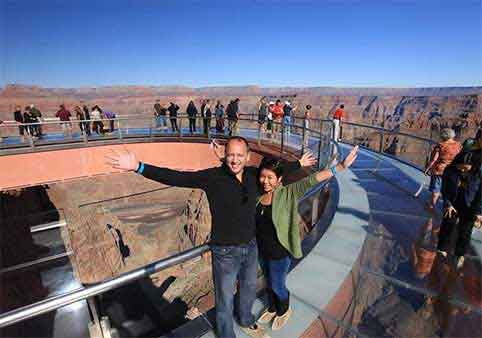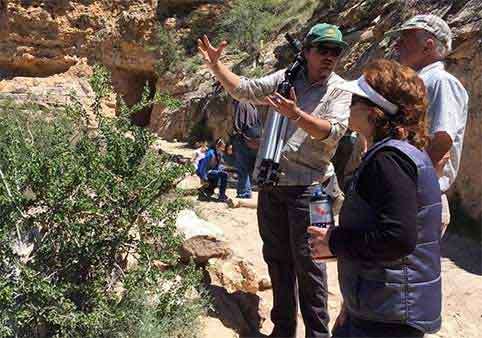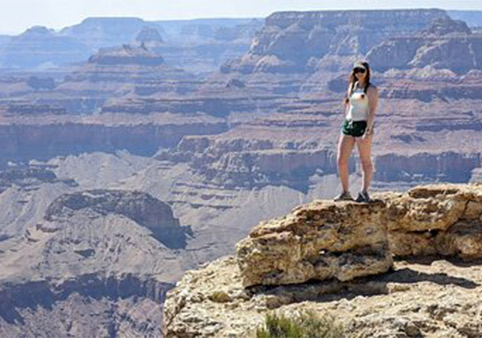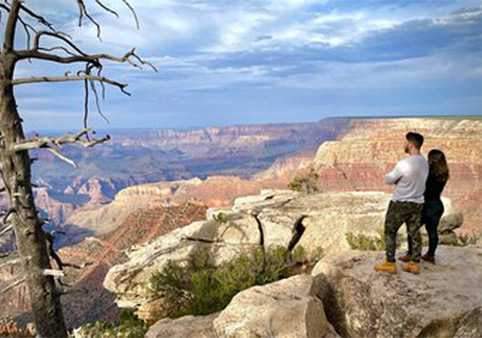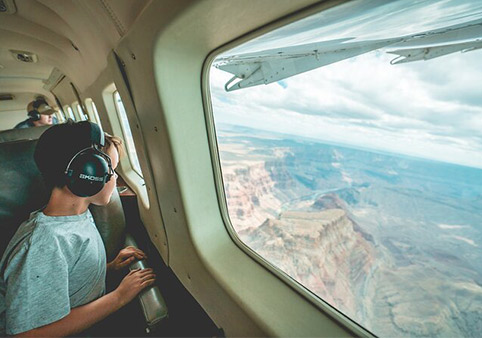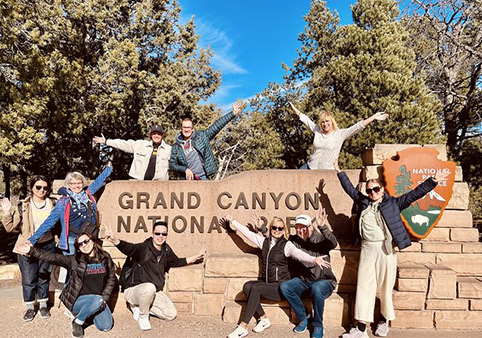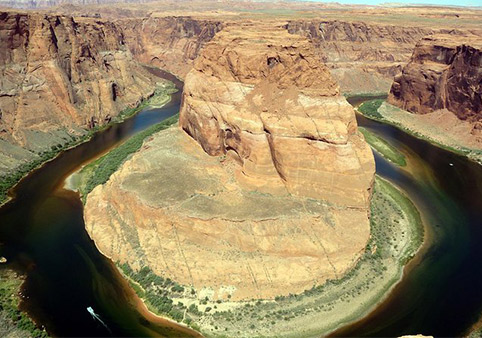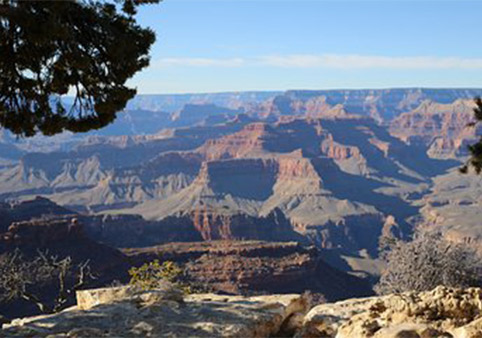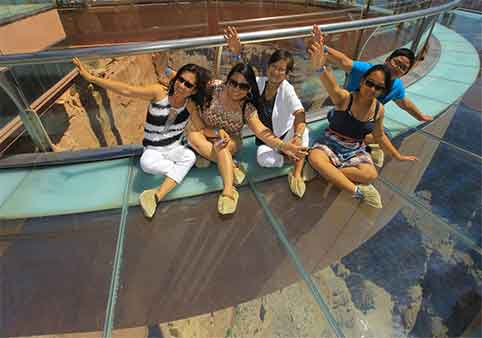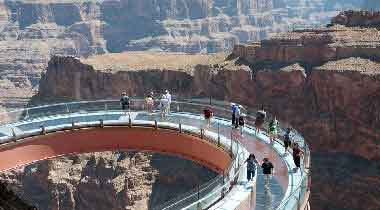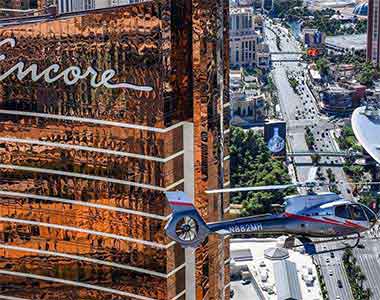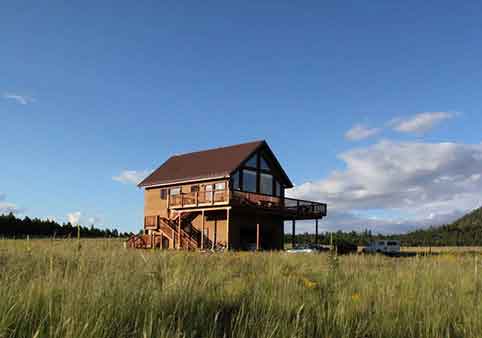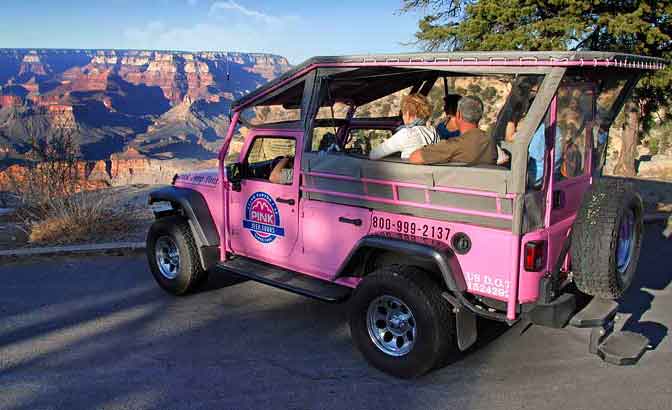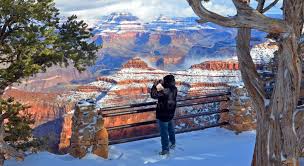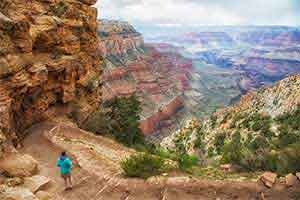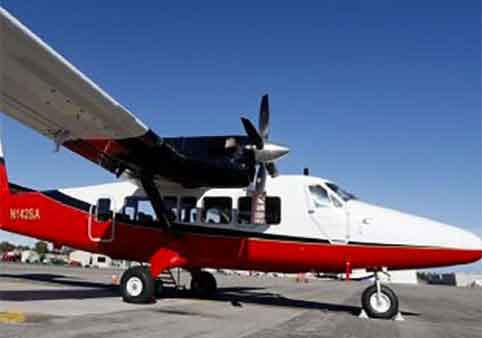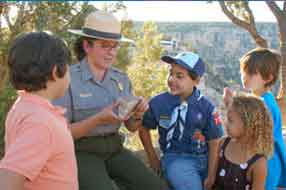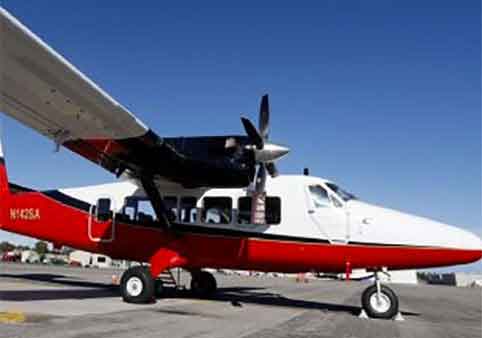Grand Canyon West Rim or South Rim?
Which should you visit - the West Rim or the South Rim of the Grand Canyon? It's a question more and more visitors are asking each year. The answer depends on several factors and ultimately comes down to whatever makes the most sense for your vacation. Read on for some questions and answers to help you figure out what you expect to get out of you Grand Canyon visit, and choose the Rim that's right for you.
Where will your trip originate? Nevada or Arizona?
If you're starting from Las Vegas, it probably makes the most sense to see the West Rim. Just a 3.5 hour drive (122 miles) from the glittering desert oasis lies Grand Canyon West, home of the Skywalk and dozens and dozens of tour options.
On the other hand, if your trip will originate from Phoenix, Flagstaff, Sedona or another Arizona city, you'll most likely want to choose the South Rim. It will probably be a shorter drive by several hours and hundreds of miles, giving you more time to enjoy the views at the rim instead of a view of your steering wheel.
How much time do you have to spend at the Grand Canyon? A half-day or 1-2+ full days?
Because the entire Grand Canyon - regardless of West or South Rim - is in a remote part of Northern Arizona, half-day driving trips to the Grand Canyon are nearly impossible unless you're already starting from Williams, located 60 miles south of the South Rim. Half-day Grand Canyon trips are do-able from Las Vegas, Williams, Flagstaff, Sedona and Phoenix when you book a helicopter or airplane tour.
Again, your origination point will influence whether you'll see the West Rim or the South Rim. If you're coming from Las Vegas and you have just a half-day to see the Grand Canyon, definitely plan on taking a helicopter or airplane tour and seeing the West Rim. The vast majority of Las Vegas helicopter and air tours land at the Grand Canyon West airport. If you're coming from Sedona or Phoenix, you can take a helicopter tour straight to the South Rim. If you're coming from Flagstaff or any other Arizona departure point, plan on driving 2 hours or more to the South Rim, then taking a 30- 45 minute helicopter tour from Grand Canyon Airport, located in the village of Tusayan.
If you have one full day to see the Grand Canyon, those driving from Las Vegas will likely choose the West Rim (a 10 hour day, including drive time) over the South Rim (an 18 hour day.) Likewise, folks coming from all points Arizona will likely want to visit the South Rim (a 12 hour day) versus the West Rim (an 16-20 hour day.)
Needless to say, if you have multiple days to see the Grand Canyon, either Rim - or even both - is do-able as long as you plan nearby overnight accommodations. The vast majority of visitors choose to stay overnight in or around the South Rim since there are far more lodging choices and room availability at the South Rim than the West Rim.
What kind of view do you expect? Deep and narrow, or wide and expansive?
The South Rim views are the classic Grand Canyon views with which you're probably familiar. Wide, expansive, and panoramic - the Grand Canyon as seen from the South Rim is an almost surreal, unbelievable sight that will leave you changed forever.
The view of the Grand Canyon from the West Rim is impressively deep, with narrower canyon walls plunging downward to the Colorado River below. Many visitors delight at the unique view of the Grand Canyon available only at the West Rim; the view from the Grand Canyon Skywalk. The view straight down through the glass cantilevered bridge offers a sometimes dizzying perspective on the Grand Canyon and the rocky chasm floor 4,000 feet down.
What kind of activities do you want to do? Hiking, river rafting, a helicopter tour or train ride?
At the West Rim, one can drive or take a helicopter or air tour from Las Vegas, land at Grand Canyon West, walk the Skywalk, fly down to the bottom of the Grand Canyon in a helicopter, ride down the Colorado River in a pontoon boat, and go back up to the Rim for a horseback ride.
At the South Rim, you'll find helicopter tours, Jeep tours, bus tours, light walking and hiking, heavy-duty backpacking and overnight backcountry camping, and the ever-popular Grand Canyon Railway train ride. Upper and Lower Canyon river rafting trips typically end and begin, respectively, at Bright Angel Trail at the South Rim.
Could the weather influence your decision?
Both the West and South Rim are open year-round. Weather extremes and moderates occur at both rims at different times of year.
February, March & April:
Late winter and early spring are glorious at the Grand Canyon. The West Rim is much warmer than the South Rim, with average temperatures as follows: February high 70 / low 43; March high 77 / low 49; April high 86 / low 56. Very little annual precipitation - only about 5.6 inches per year - means you're almost guaranteed clear, sunny conditions at the West Rim which is great because rain can make the 15 mile unpaved road a little trickier than usual. But it also means you should definitely pack the sunscreen as waiting in line for the Skywalk can get pretty sunny during the approximate one hour wait.
At the South Rim, average high/low temperatures at the South Rim are as follows each month: Feburary high 45 / low 21; March high 51 / low 25; April high 60 / low 32. Expect to see breath-taking views of snow blanketing the Grand Canyon's surrounding plateau and settled on the nooks and crannies of the chasm walls. Snow can make hiking or walking on the rim trail tricky, so be even more careful than usual and obey posted signs and guard rails.
May, June, July, August & September:
The spring and summer months are THE most popular season for visiting the Grand Canyon. If you're headed for the Grand Canyon Skywalk on the West Rim, be prepared to experience hot, dry summer temperatures and wear tons of sunscreen and/or a wide-brimmed hat and drink plenty of water. Average summer temps at the West Rim are: May high 96 / low 65; June high 108 / low 73; July high 113 / low 79; August high 110 / low 78; September high 102 / low 70.
Average temperatures for the South Rim are: May high 70 / low 39; June high 81 / low 47; July high 84 / low 54; August high 81 / low 53; September high 76 / low 47. In July and August, when the dew point rises, Arizona experiences monsoon rains. Quick, intense thunderstorms contribute to the rapid-shift swings in weather in the summertime, but locals will tell you that the monsoon season is one of their favorite times of year because it brings relief to seasonally high temperatures and makes the landscape incredibly verdant and fragrant. The Grand Canyon's spectacular vistas just 'pop' against a stormy background.
October, November, December & January:
Do come to the Grand Canyon in winter... you'll love the views and even more you'll love how few other visitors there are!
Because the West Rim is at a lower elevation than the South Rim (4,000 feet above sea level versus 7,200 feet), it's much warmer in the fall and winter months, with little to no snow. Average high temperatures range from 64 - 89 degrees F and lows range from 58 to 38 degrees F.
At the South Rim, the average high in October, November, December & January is between 64 and 40 degrees F and the low between 35 and 18 degrees F. You can expect snow at the South Rim, which makes for some unbelievably beautiful views of the Canyon, but you must be willing to pack on the layers and get out of your car to see them.
Whether you are leaning toward the West Rim or South Rim, you'll need enough warm, layered clothing to stand being outside in cool-to-cold temperatures for an hour or so to wait in line for the Skywalk, take pictures, walk along the Rim trail or the West Rim viewpoints and tour Grand Canyon Village, etc. Expect some pretty moderate-to-strong winds, too, which can bring the temperature down considerably at either rim.
Is your vacation budget a factor? Could cost make a difference?
The cost of seeing the West Rim differs from the cost of seeing the South Rim. In short, the South Rim is less expensive with regard to entrance fees, parking and shuttle costs (about $25.) The West Rim, which is not part of Grand Canyon National Park but is owned and operated by the Hualapai native American tribe; the Hualapai collect fees for entrance to the West Rim (a minimum of $42.99.)
At the South Rim, entrance to the park is $25 per private vehicle, $10 per pedestrian or cyclist. Fees for commercial bus passengers vary. Admission is for seven days and includes both the South and North Rims. No refunds due to inclement weather. U.S. residents aged 62 or older may obtain a Golden Age Passport for a one-time fee of $10.00. There is no additional cost to park or ride the hop-on-hop-off shuttles around the South Rim.
At the very least, each West Rim visitor is required to purchase the Legacy Package, priced at $42.99 (including all taxes and fees) per adult (as of February 2014)
This basic package includes the hop-on-hop-off shuttle, other attractions like Hualapai Ranch, Eagle Point, Guano Point, Native American demonstrations and cowboy performances at three viewpoints Hualapai visitation certificate, and photo opportunities with Hualapai members, but does not include tickets to walk on the Skywalk. See our Grand Canyon West Rim page for detailed package pricing.
No private vehicles are permitted past the Grand Canyon West entrance, located at the end of a 9-mile graded but bumpy dirt road called Diamond Bar road. You must park your car at the Grand Canyon West Welcome Center and ride the hop-on-hop-off shuttle to the West Rim attractions.
Do you follow the majority or the minority of visitors?
Simply put, the majority of visitors come to the South Rim each year. Compare 4 million annual South Rim visitors to 200,000 visitors at the West Rim. There is a good reason people flock to the South Rim; it's actually part of Grand Canyon National Park; it's stunningly beautiful; it's more developed by way of visitors centers and services; there's more lodging nearby; you can hike, backpack and camp; it's easier to access and is more centrally located for Arizona visitors; and it offers more activity and tour variety.
The West Rim is emerging as a destination so it offers fewer options for lodging, services, visitor centers and variety when it comes to activities and tours. Because it's not a part of Grand Canyon National Park but actually owned and operated by the Hualapai Tribe on tribal land, Grand Canyon West is more a tour destination and pay-for-admission attraction than the National Park. It's proximity to Las Vegas, unique Skywalk attraction, beautiful rugged views, and plethora of Las Vegas tour packages make the West Rim a fantastic choice for more and more of the Grand Canyon-bound each year.
RECOMMENDED WEST RIM & SOUTH RIM SERVICES
Grand Canyon South Rim Tour from Phoenix & Scottsdale
Marvel at the beauty that is the South Rim during this Grand Canyon Tour from Phoenix & Scottsdale. Highlights include a day trip to visit Arizona’s breathtaking Grand Canyon National Park, a scenic drive with views of the San Francisco Peaks in Flagstaff, and several viewpoints at the … More
Marvel at the beauty that is the South Rim during this Grand Canyon Tour from Phoenix & Scottsdale. Highlights include a day trip to visit Arizona’s breathtaking Grand Canyon National Park, a scenic drive with views of the San Francisco Peaks in Flagstaff, and several viewpoints at the spectacular Grand Canyon South Rim. Optional "Colors & Canyons" 45-minute helicopter upgrade available.
Professionally Guided | Hotel Pickup | Private Tours Available | Custom Options Available | Family-Friendly
Sheridan House Inn - Williams
No Children Accommodated | Romantic | Award Winning | Custom Options Available | Breakfast Included | Optional Intimate Personal Chef Cooked Dinners | Private Porch or Balcony | Hot Tub | Perfect for Special Occasions
Grand Canyon Hotel & Suites
Grand Canyon South Rim Self-Guided Driving Tour
Additional Tours Available | Family-Friendly | Self-Guided
Mountain Modern
Our recently expanded Sedona hotel has all you need for the ultimate Sedona vacation. From an outdoor heated pool and hot tub to a bike repair station to keep you in tip-top shape, fire pits perfect for congregating, and The Den, o … More
Our recently expanded Sedona hotel has all you need for the ultimate Sedona vacation. From an outdoor heated pool and hot tub to a bike repair station to keep you in tip-top shape, fire pits perfect for congregating, and The Den, offering all day dining options, grab-and-go, and a full bar, we have all you’ll need and then some.
Family-Friendly | Pet-Friendly | Fireplace(s) | Outdoor Fireplace/Pit | Outdoor Pool | Hot Tub | Free Hot Breakfast | Sedona Hotels & Lodging
Wildland Trekking
Popular Hikes | Professionally Guided | Popular Hikes | Leaves from Flagstaff | Leaves from Grand Canyon/Tusayan
Best Grand Canyon Day Tour
Voted on Trip Advisor as the most popular Grand Canyon day tour. This is the best way to enjoy the Grand Canyon without doing any strenuous hiking. Nearly five million people come to see the Canyon each year and many spend much of their time trying to figure out what to do. Our professi … More
Voted on Trip Advisor as the most popular Grand Canyon day tour. This is the best way to enjoy the Grand Canyon without doing any strenuous hiking. Nearly five million people come to see the Canyon each year and many spend much of their time trying to figure out what to do. Our professional guides will make sure you get the most out of your trip. While touring in comfort you will learn about the geology and history of one of the Seven Natural Wonders of the World. The day tour includes short walks to some incredible "less-used" outlooks, a looking into some of the areas most impressive historic buildings, and time to browse resident art galleries and gift shops.
Family-Friendly | Leaves from Flagstaff | Optional Air Tour | Professionally Guided | Lunch Provided
The Squire at Grand Canyon
Family-Friendly
Private Grand Canyon Hiking Tours
Professionally Guided | Lunch Provided | Hotel Pickup
Arizona Mountain Inn & Cabins - Flagstaff
Family-Friendly | Pet-Friendly | Flagstaff Hotels & Lodging
Grand Canyon South Rim Tour from Phoenix & Scottsdale with Sedona
Professionally Guided | Private Tours Available | Hotel Pickup | Family-Friendly
Oak Creek Terrace Resort - Sedona
Located on Oak Creek | Family-Friendly | Fireplace(s) | Hot Tub | Sedona Hotels & Lodging
Grand Canyon UTV Tours
Family-Friendly | Professionally Guided | Leaves from Williams | Professionally Guided
Junipine Resort
On-site Restaurant | Family-Friendly | Kitchenette or Full Kitchen | Fireplace(s) | Fitness Center | Hot Tub
Grand Canyon Getaway
Family-Friendly
Briar Patch Inn - South Rim
Briar Patch Inn is the #1 Ranked B&B in AZ since 2011 and has received Trip Advisor's Certificate of Excellence
The Briar Patch Inn features 19 cabins situated on 9 lush acres in Oak Creek Canyon, just 3 miles north of Sedona. Each individual cabin is dressed in
… More
Briar Patch Inn is the #1 Ranked B&B in AZ since 2011 and has received Trip Advisor's Certificate of Excellence
The Briar Patch Inn features 19 cabins situated on 9 lush acres in Oak Creek Canyon, just 3 miles north of Sedona. Each individual cabin is dressed in distinctly different southwestern decor. The lush grounds - home to wildlife, birds, and two resident sheep - showcase rambling walking paths, canyon oaks, giant pines, and sycamores, all providing the perfect setting to nurture your relationship with nature. Healthy, bountiful, homemade breakfasts are offered by the creek in spring and summer and by the lodge fireplaces in fall and winter. An attentive, longtime staff strives to provide a quality of fine service that is the hallmark of this "magical" sanctuary. A Fodor's Choice and a Frommer's favorite.
Fireplace(s) | Free Hot Breakfast | Family-Friendly | Romantic | Kitchenette or Full Kitchen | Good for Nature Lovers | Intimate Wedding Venue | Retreat & Workshop Venue
Canyon Villa Bed & Breakfast Inn Of Sedona
Outdoor Pool | Free Hot Breakfast | Sedona Hotels & Lodging
Munds Park RV Resort
Flagstaff Hotels & Lodging | Family-Friendly | Pet-Friendly | General Store | Laundry | Shower | BBQ/Grill | Dump Station | Fitness Center
Maverick Helicopter Tours from Las Vegas
Leaves from Las Vegas
Raptor Ranch RV Park & Campground
RAPTOR RANCH Campground is only 20 MINUTES FROM THE SOUTH RIM ENTRANCE!
We are located close to the Grand Canyon. The campground offers 32 RV Sites, 25+ Tent Sites. FREE Raptor Flight Demonstrations to All Campers! and FREE admission to Bedrock City.
There is free WiF … More
RAPTOR RANCH Campground is only 20 MINUTES FROM THE SOUTH RIM ENTRANCE!
We are located close to the Grand Canyon. The campground offers 32 RV Sites, 25+ Tent Sites. FREE Raptor Flight Demonstrations to All Campers! and FREE admission to Bedrock City.
There is free WiFi Available in Lounge & Laundry Room. We have a Grocery Store on Site, Campfire Rings, Firewood Available at the Camp Store, Giftshop, Showers, Snacks, Coffee, and an Overflow Parking.
Check-In: 1:00 pm, Check-Out: 12:00 pm
Outdoor Fireplace/Pit | Propane Refilling Station | Pet-Friendly | Laundry | Shower | Dump Station | Community Restrooms | WiFi | General Store
Western River Expeditions
Leaves from Las Vegas | Professionally Guided | Popular Hikes | Family-Friendly
Grand Canyon Railway
Family-Friendly | Leaves from Williams
Sedona & Red Rock State Park Self-Guided Driving Tour
Self-Guided | Family-Friendly | Additional Tours Available
Canyon Dave Tours
Family-Friendly | Private Tours Available | Family Business | Custom Options Available | Multi-Attraction Tours | Multi-Day Tours
Papillon Grand Canyon Helicopters
Family-Friendly | Leaves from Las Vegas | Leaves from Grand Canyon/Tusayan | Optional Skywalk Tour
Maverick Helicopter Tours from GCNP Airport
Canyon Spirit is a Grand Canyon helicopter tour that departs from the South Rim, taking you over the beautiful Kaibab National Forest, home to the world's largest stand of Ponderosa pines. Upon reaching the edge, the rim drops away as the magnificent Grand Canyon comes into full view.… More
Canyon Spirit is a Grand Canyon helicopter tour that departs from the South Rim, taking you over the beautiful Kaibab National Forest, home to the world's largest stand of Ponderosa pines. Upon reaching the edge, the rim drops away as the magnificent Grand Canyon comes into full view.
Leaves from Grand Canyon/Tusayan | Family-Friendly | Professionally Guided
Arizona Private Tours
Leaves from Flagstaff | Family-Friendly | Custom Options Available | Professionally Guided
Backland Luxury Camping
Take your loved ones on a trip they will never forget. Backland is a luxury eco-resort near the Grand Canyon. Completely surrounded by ponderosa pine forests, our one-of-a-kind tents, chef-prepared meals, and secluded location completely redefine the concept of glamping. Dine by the fir … More
Take your loved ones on a trip they will never forget. Backland is a luxury eco-resort near the Grand Canyon. Completely surrounded by ponderosa pine forests, our one-of-a-kind tents, chef-prepared meals, and secluded location completely redefine the concept of glamping. Dine by the fire in our glass-walled restaurant, relax with a massage in our tented spa, marvel at the grandeur of the universe through our complimentary telescopes, and take advantage of miles of nearby hiking trails.
-
Features:
- Complimentary Breakfast
- Onsite Glass Walled Restaurant
- Onsite and nearby hiking trails
- Close to the Grand Canyon and dozens of local attractions
- Pond with sand beach, fishing, and kayaking
- Snowshoes and sledding onsite when it snows
-
Tents feature:
- Panoramic windows
- Huge stargazing skylights over the beds (Skyview tents only)
- Automatic climate control, fully insulated, and energy-efficient
- King-sized beds
- Full en-suite bathroom with showers
- Luxury linens
- Electricity in tents
- Tentside parking + electric vehicle charging at reception
- Private Outdoor patios
- Coffee makers + mini-fridges
- Ecological toiletries + water conservation fixtures
Pet-Friendly | Outdoor Fireplace/Pit | Family-Friendly | Outdoor Fireplace/Pit | Outdoor Rental Equipment Available | Games Provided | Hot Drinks Provided | Spa | Eco-Friendly | On-site Restaurant | Breakfast Included
The Grand Hotel - Grand Canyon Village
Family-Friendly | On-site Restaurant | Indoor Pool | Hot Tub | Business Center | Fireplace(s)
Pink Jeep Tours
Family-Friendly | Lunch Provided | Multi-Attraction Tours | Combination Tour | Leaves from Las Vegas | Leaves from Sedona
Grand Canyon West Rim Bus or Private Tour
Optional Skywalk Tour | Leaves from Las Vegas | Hotel Pickup | Breakfast Included | Lunch Provided | Family-Friendly | Professionally Guided
Fun 66 Tours
Multi-Attraction Tours | Family-Friendly | Leaves from Williams | Professionally Guided
Small-Group Grand Canyon West Rim Day Trip from Las Vegas with Optional Skywalk
Leaves from Las Vegas | Breakfast Included | Lunch Provided | Hotel Pickup | Optional Skywalk Tour | Family-Friendly | Professionally Guided
Grand Canyon Hike & Sightseeing Tour
Enjoy a great tour with a knowledgeable, friendly, enthusiastic guide who loves what they do. We provide door-to-door service from your stay place with everything you need to have a great time. Grab your camera and leave the lunch, snacks, beverages, hiking equipment, and driving to us! … More
Enjoy a great tour with a knowledgeable, friendly, enthusiastic guide who loves what they do. We provide door-to-door service from your stay place with everything you need to have a great time. Grab your camera and leave the lunch, snacks, beverages, hiking equipment, and driving to us! We pick up in the following towns: Flagstaff, Williams, Tusayan, and Grand Canyon.
Currently, the Park Service is not allowing us to mix groups due to COVID-19 safety procedures, so we are unable to provide this tour for less than 4 people. If you have a smaller group, please reach out to our company directly to discuss other options. By far our most popular hiking tour, this hike and sightseeing tour offers guests varying views of the Canyon, from the inside out. This tour is for guests who want to enjoy an excellent tour of the South Rim of the Grand Canyon, but also spend some time below the Rim.
Popular Hikes | Lunch Provided | Hotel Pickup | Professionally Guided | Gear Provided
Sedona and Grand Canyon Full-Day Tour
Multi-Day Tours | Multi-Attraction Tours | Private Tours Available | Combination Tour
Small Group Grand Canyon National Park Day Tour from Phoenix
Private Tours Available | Multi-Day Tours | Multi-Attraction Tours
Grand Canyon South Rim Signature Air & Ground Tour with PJX
Private Tours Available | Combination Tour | Multi-Day Tours | Multi-Attraction Tours
Grand Canyon with Sedona and Oak Creek Canyon Van Tour
Private Tours Available
Antelope Canyon and Horseshoe Bend Day Adventure from Scottsdale or Phoenix
Private Tours Available | Multi-Attraction Tours | Multi-Day Tours | Combination Tour
Full-Day Guided Trip to The Grand Canyon from Phoenix
Multi-Day Tours | Private Tours Available | Multi-Attraction Tours
Grand Canyon West Rim Bus Tour from Las Vegas with Optional Upgrades
Leaves from Las Vegas | Optional River Tour | Optional Air Tour | Optional Skywalk Tour | Professionally Guided | Hotel Pickup | Lunch Provided


